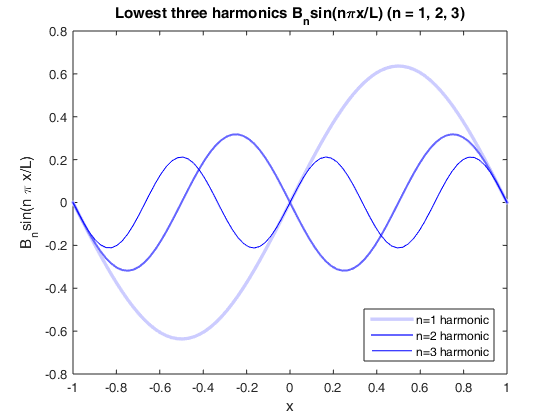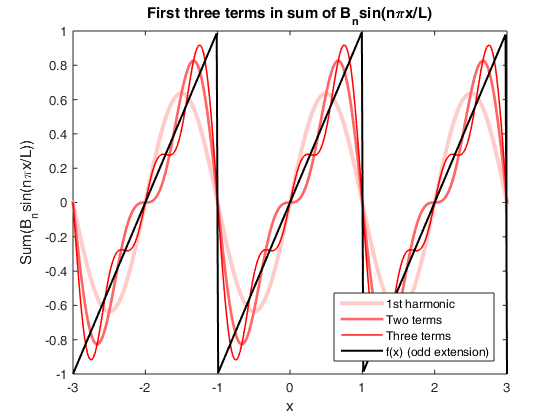Fourier series example (Math 331, Fall 2016, Lecture 1, Matveev)
Here we plot the Fourier series of a simple linear function f(x)=x Since this is odd function, the Fourier series converges to an odd periodic extension of the function, which is a saw-tooth
Contents
Plot of the individual harmonics
Note the alternating sign
L = 1; x = linspace(-L, L, 80); % Parition the interval [-L, L] into points Const = -2*L/pi; % Constant in the expression for B_n for n = 1 : 3 Const = -Const; % Efficient way to implement alternating sign Bn = Const/n; % Coefficients inversely proportional to n Fn = Bn * sin(n*pi*x); plot(x, Fn, 'color', [0 0 1] + (3-n)/2.5*[1 1 0], 'linewidth', 3.5-n); hold on; end xlabel('x'); ylabel('B_nsin(n \pi x/L)'); title('Lowest three harmonics B_nsin(n\pix/L) (n = 1, 2, 3)'); legend('n=1 harmonic', 'n=2 harmonic', 'n=3 harmonic', 'Location', 'Southeast');

Plot the Fourier series
Now we add the above harmonics: see how they add up to reproduce f(x)=x
hold off; x = linspace(-3*L, 3*L, 300); % Enlarge the interval to 3 periods Const = -2*L/pi; % Constant in the expression for B_n Sn = zeros(size(x)); % Initialize vector of series sum values for n = 1 : 3 Const = -Const; % Efficient way to implement alternating sign Bn = Const/n; % Coefficients inversely proportional to n Fn = Bn * sin(n*pi*x); Sn = Sn + Fn; plot(x, Sn, 'color', [1 0 0] + (3-n)/2.5*[0 1 1], 'linewidth', 4-n); hold on; end xlabel('x'); ylabel('Sum(B_nsin(n\pix/L))'); title('First three terms in sum of B_nsin(n\pix/L)'); plot(x, mod(x+1,2)-1, 'k-', 'linewidth', 1.5) legend('1st harmonic', 'Two terms', 'Three terms', 'f(x) (odd extension)', 'Location', 'Southeast'); % Note how the sum approaches the odd periodic extension of f(x)
